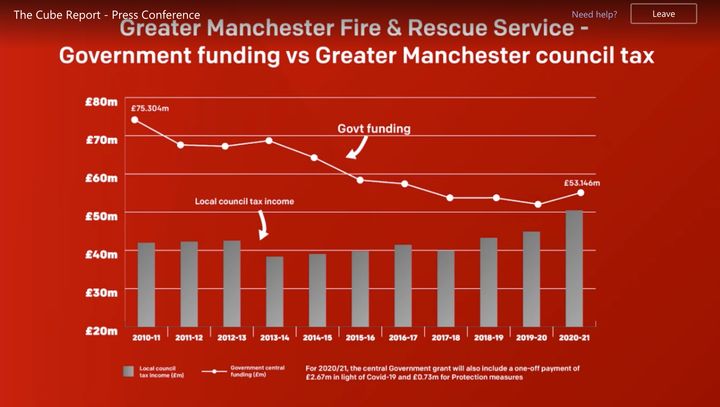Two million people within 500 square miles were left with just five fire engines to protect them because so many had to be diverted to the Bolton student tower block blaze in November last year.
It has led to calls from the region’s mayor Andy Burnham for an end to fire service cuts.
The alarming revelation was made as Greater Manchester Fire and Rescue Service published a report into the inferno that consumed The Cube on November 15 – started by a discarded cigarette.
Around 130 firefighters battled the blaze.
The 217 residents, students at the University of Bolton, were all accounted for after flames spread rapidly across the block, which was clad with high pressure laminate cladding of a different type from that involved in the Grenfell Tower disaster of 2017.
Witnesses to the Bolton blaze said what appeared to be a small fire ripped across and upwards within minutes, “crawling up the cladding like it was nothing”. One resident had to be rescued from the sixth floor with a cherry picker, her flat vanishing into smoke and flames just minutes later.
A report published on Thursday by Greater Manchester Fire and Rescue Service (GMFRS) into the blaze concluded flames spread rapidly and posed a real risk to residents’ safety.
The Grenfell Tower disaster put so-called “stay put” policies – where residents are asked to remain inside their own properties as the buildings are designed to stop fires spreading – into sharp focus.
Many living in Grenfell Tower had been told staying put would keep them safe from the encroaching blaze, but tragically became trapped in their homes.
The GMFRS report into The Cube fire states: ″The recognition early into the incident that the building was failing to contain the fire, multiple fire spread patterns and the loss of integrity of the protected stairwells resulted in the IC [incident commander] realising the need for an immediate and full evacuation of The Cube.
“NWFC’s [North West Fire Control] subsequent and clear change of advice to callers from ‘stay put’ to ‘evacuate’, it is considered, contributed to the reduction of injury and allowed all persons to safely leave the building.”
As it happened, The Cube did in fact have an evacuation strategy, which meant occupants were meant to clear out at the sound of the alarm – so it is not clear why anyone might have been advised to “stay put” in the first place. Usually 999 callers are asked to comply with whatever they believe their fire policy to be, but it is not clear whether all the students knew this. Some were already leaving the building when the brigade arrived, but they weren’t doing so quickly enough.
The evacuation, once fire chiefs sped it up, is thought to have saved many lives.
Tony Hunter, assistant chief fire officer for GMFRS, said: “The decision at this incident was made through the incident commander calling the immediate evacuation.
“It made very clear that building had to be evacuated and therefore any calls received by North West Fire Control would have supported that higher message.
“Therefore resident calls up, says ‘smoke near my flat’, they would have been told to evacuate there and then.
“Obviously the circumstances from this fire were significantly different from the Grenfell inquiry with regards to the change from ‘stay put’. This had an evacuation strategy, it had a full alarm system, and evacuation was already under way when we got there.
“The incident commander rightly noticed that it wasn’t going as quickly as it should have been and the fire was developing in a way that it also shouldn’t have been doing.”
On the night in question, 27 fire engines from across Greater Manchester were in attendance at the fire in Bolton town centre, and 18 fire engines from other services also had to be called in to attend.
At one point during the incident there were just five pumps left to cover the entire region. On a normal evening that figure would be close to 50.
Greater Manchester mayor Andy Burnham said he would be writing to home secretary Priti Patel to draw attention to the way the region’s resources “were stretched to the very limit”, calling for an end to cuts to the service’s budget, greater regulation of student housing and urgent intervention to address the unsafe cladding that continues to encase thousands of buildings across the UK.

The report published on Thursday explicitly focused on the response of the fire service, and did not examine the way the fire spread or its cause – beyond the probable conclusion that it had initially sparked from a discarded cigarette.
A full report into the fire – particularly the role the cladding played – is expected to be published soon.
David Greenhalgh, leader of Bolton Council, said: “The discussion around resources has to be tackled through building regulations.
“If we get the building regulations right it will have a natural impact on the sheer spread of the fire on that night, which is not what should have happened to a building that passed all the regulations.
“It simply should not have been the case – it failed. Therefore there’s something completely wrong with the regulations and the criteria. I personally watched a walkway melt before my eyes that night.
“Afterwards, when I was asking, it was deemed ‘not combustible’. If those tests are not performed at inferno levels instead of just putting a blow torch on something, then there are some serious problems with the way in which we conduct our levels of investigation.”
